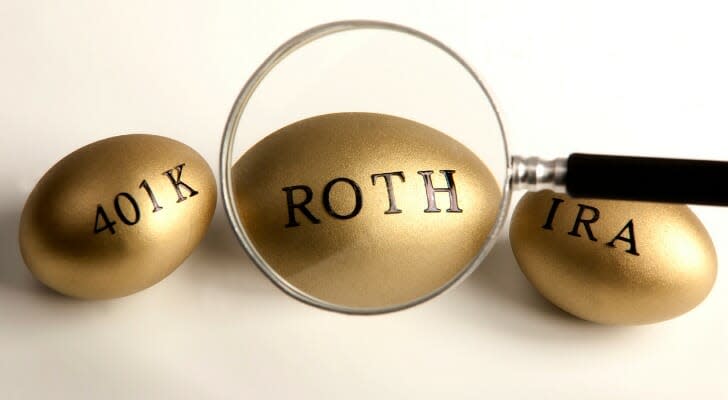How to Roll Over Your 401(k) Plan to a Roth IRA

When you leave a job where you had a 401(k) plan, you might choose to roll over that plan an individual retirement account (IRA). Such rollovers are fairly straightforward; the transfer of assets isn’t a taxable event, and your savings will continue to grow tax-deferred. But some might take this opportunity to roll over some or all of their funds to a Roth IRA instead.
Doing so may make sense for your taxes and overall financial plan. But it does mean paying a one-time tax bill for the amount you’ve converted. And you should also understand that converting to a Roth IRA is a permanent process. You won’t be able to change your mind and go back to a traditional IRA. Because of this, it’s important to understand the difference between the two plans before you begin the process of rolling over your 401(k).
Roth IRA vs. Traditional IRA
Traditional IRAs are tax-deferred. That means that you don’t have to pay taxes on your contributions, but you do pay taxes on the money you take out. They are similar to 401(k) plans in this way. With a 401(k), your employer diverts the money from your paycheck before it faces taxes. Since you contribute the money yourself to an IRA, it’s on you to take a tax deduction to avoid paying.
The money in an IRA grows without being taxed until you start taking distributions. Once you reach age 59.5, you can start taking distributions from your IRA, and the funds you withdraw will be taxed as ordinary income. Traditional IRAs also come with Required Minimum Distributions (RMDs) that kick in when you hit age 70.5. You can’t let the money sit in the account to grow as long as you like. Age 70.5 is also when you can no longer contribute to a traditional IRA.
By contrast, you fund a Roth IRA with after-tax dollars. That means you won’t deduct contributions to a Roth IRA. Rather, the advantage comes once you reach retirement. Because you paid taxes before as you contributed to the account, you don’t have to pay taxes when you start receiving distributions. A Roth IRA doesn’t have RMDs like its traditional counterpart, so you can leave the money untouched indefinitely if you prefer. You can also keep contributing to a Roth IRA at any age. A Roth IRA can come in handy if you’d rather pay taxes sooner than later. It’s also nice because the return you earn on the investments in your Roth IRA will never end up being taxed.
Rolling Over Your 401(k)

Your first step will be to open a Roth IRA. You can do this at virtually any major brokerage firm. Do some research, then head to your bank’s or firm’s website to open your account. Once you’ve done that, you can contact the company managing your 401(k) account to begin the rollover process. You can do this online or over the phone. Your 401(k) plan administrator will then transfer your funds into your new Roth IRA account, and you’ll be ready to choose how to invest your new IRA.
This process is known as a direct rollover, and it’s the easiest way to do it. There are also indirect rollovers, in which the balance of the account is distributed directly to you (typically as a check). In this case, you’ll have 60 days from the date you receive the funds to transfer the money to your custodian or IRA company. If you don’t deposit the funds withing the 60 days, the IRS will treat it as a taxable withdrawal, and you’ll face a 10% penalty if you’re younger than 59.5. This risk is why most people choose the direct option. With either rollover option, you’ll also have to make sure you’ve satisfied any special requirements the company might have. If you’re looking to roll over only a portion of your 401(k), you’ll need to check with your plan administrator to see if that’s something they allow.
Paying Taxes on Your Contributions

The point of a Roth IRA is that the money gets taxed as income upfront, then grows tax-free. But the money in your 401(k) was shielded from taxes (by being withheld from your paycheck). So you’ll now need to pay income tax on that money so that it qualifies for a Roth.
The funds in your account are added to your taxable income for the year you do the rollover. Income taxes you owe will be calculated from that new total. Since the “income” from your IRA isn’t coming from a paycheck, though, the tax you owe on it won’t be withheld. To make up for this, you may need to make an estimated tax payment during the quarter that you rollover.
You’ll need to do this if the taxes you’re paying through withholding aren’t enough to constitute the smaller of a) 90% of the taxes you’ll owe for the tax year of your rollover or b) 100% of the taxes you paid for the previous tax year (this figure is 110% if your adjusted gross income was higher than $150,000 in 2018). Once you know your estimated payment, you can either pay it all at once or split the amount between the quarters remaining in the tax year. Quarterly estimated tax payments are due on or before April 15, June 17, Sept. 16 and Jan. 15 of the next year.
If you overestimate how much your tax bill is going up and overpay your estimated tax payments, that’s OK. You’ll get a refund if you end up paying more than you owe.
If you’re converting a large balance to a Roth, your tax bill for the year could go up substantially. That’s especially true if the extra “income” pushes you into a higher tax bracket. To blunt this impact, you might convert a little of the money at a time over the next few years to keep yourself in a lower bracket. To accomplish this, you can open a Traditional IRA and roll over your 401(k) funds into there. Then, over the next few years, you can do partial conversions of those funds into a Roth IRA. By spreading out your conversion, you avoid having a huge tax bill to pay all at once, and perhaps keep yourself in a lower bracket.
Tips for Saving for Retirement
Having trouble figuring out how taxes fit into your retirement plan? It may be smart to work with a financial advisor on such decisions. An advisor can take a comprehensive look at your finances and identify opportunities to save on taxes and grow your nest egg. To find a financial advisor in your area, we recommend using SmartAsset’s financial advisor matching tool. Just answer some questions about your financial goals and situation, and the tool will pair you with up to three qualified financial advisors in your area.
As you plan for your retirement income, you should also consider how Social Security benefits fit into the equation. Our Social Security calculator can help in this regard. Fill in your age, income and target retirement date and we’ll calculate what you can expect in annual benefits.
Photo Credit: ©iStock.com/jygallery, ©iStock.com/Peopleimages, ©iStock.com/AndreyPopov
The post How to Roll Over Your 401(k) Plan to a Roth IRA appeared first on SmartAsset Blog.
